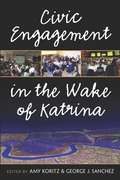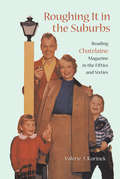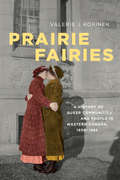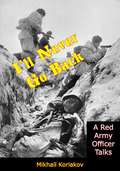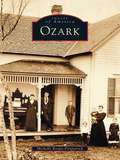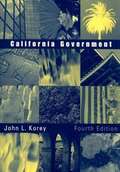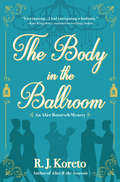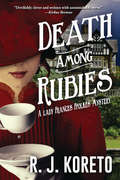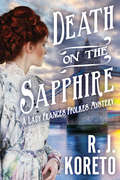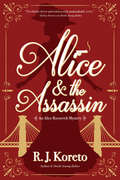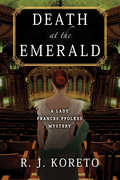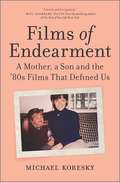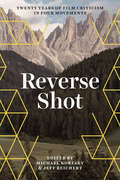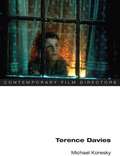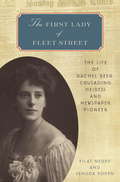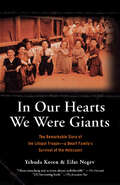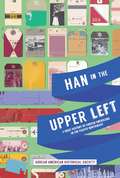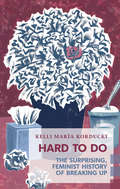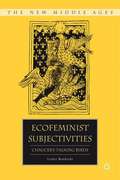- Table View
- List View
Civic Engagement in the Wake of Katrina
by Amy Koritz George J. SanchezThis collection of essays documents the ways in which educational institutions and the arts community responded to the devastation wrought by Hurricane Katrina. While firmly rooted in concrete projects, Civic Engagement in the Wake of Katrina also addresses the larger issues raised by committed public scholarship. How can higher education institutions engage with their surrounding communities? What are the pros and cons of "asset-based" and "outreach" models of civic engagement? Is it appropriate for the private sector to play a direct role in promoting civic engagement? How does public scholarship impact traditional standards of academic evaluation? Throughout the volume, this diverse collection of essays paints a remarkably consistent and persuasive account of arts-based initiatives' ability to foster social and civic renewal.
Roughing it in the Suburbs
by Valerie J. KorinekOriginally launched in 1928, by the 1950s and 1960s nearly two million readers every month sampled "Chatelaine" magazine's eclectic mixture of traditional and surprisingly unconventional articles and editorials. At a time when the American women's magazine market began to flounder thanks to the advent of television, "Chatelaine's" subscriptions expanded, as did the lively debate between its pages.Why?In this exhilarating study of Canada's foremost women's publication in the 50s and 60s, Valerie Korinek shows that while the magazine was certainly filled with advertisements that promoted domestic perfection through the endless expansion of consumer spending, a number of its sections - including fiction, features, letters, and the editor's column - began to contain material that subversively complicated the simple consumer recipes for affluent domesticity. Articles on abortion, spousal abuse, and poverty proliferated alongside explicitly feminist editorials. It was a potent mixture and the mail poured in - both praising and criticizing the new directions at the magazine.It was "Chatelaine's" highly interactive and participatory nature that encouraged what Korinek calls "a community of readers" - readers that in their very response to the magazine led to its success. "Chatelaine" did not cling to the stereotypical images of the era, instead it forged ahead providing women with a variety of images, ideas, and critiques of women's role in society. Chatelaine's dissemination of feminist ideas laid the foundation for feminism in Canada in the 1970s and after.Comprehensive, fascinating, and full of lively debate and history, "Roughing it in the Suburbs" provides a cultural study that weaves together a history of "Chatelaine's" producer's, consumers, and text. It illustrates how the structure of the magazine's production, and the composition of its editorial and business offices allowed for feminist material to infiltrate a mass-market women's monthly. In doing so it offers a detailed analysis of the times, the issues, and the national cross section of the women and, sometimes, men, who participated in the success of a Canadian cultural landmark.Winner of the Laura Jamieson Prize, awarded by the Canadian Research Institute for the Advancement of Women
Prairie Fairies: A History of Queer Communities and People in Western Canada, 1930-1985 (Studies in Gender and History)
by Valerie KorinekPrairie Fairies draws upon a wealth of oral, archival, and cultural histories to recover the experiences of queer urban and rural people in the prairies. Focusing on five major urban centres, Winnipeg, Saskatoon, Regina, Edmonton, and Calgary, Prairie Fairies explores the regional experiences and activism of queer men and women by looking at the community centres, newsletters, magazines, and organizations that they created from 1930 to 1985. Challenging the preconceived narratives of queer history, Valerie J. Korinek argues that the LGBTTQ community has a long history in the prairie west, and that its history, previously marginalized or omitted, deserves attention. Korinek pays tribute to the prairie activists and actors who were responsible for creating spaces for socializing, politicizing, and organizing this community, both in cities and rural areas. Far from the stereotype of the isolated, insular Canadian prairies of small towns and farming communities populated by faithful farm families, Prairie Fairies historicizes the transformation of prairie cities, and ultimately the region itself, into a predominantly urban and diverse place.
Nigeria and World War II: Colonialism, Empire, and Global Conflict
by Chima J. KoriehBritain's declaration of war on Germany on 3 September, 1939, made Nigeria, like many other African societies, active participants in the war against the Axis powers. Leading to large-scale mobilization of human and materials resources, it transformed lives and societies in irrevocable ways. Of the 90,000 West African soldiers deployed to South East Asia after 1943, over half came from Nigeria. In this important, revisionist history, Chima J. Korieh examines how the lives of Nigerian producers, workers, merchants, men, women, and children from across society were affected. It recounts the extraordinary and often neglected story of the Nigerian people who were drawn into a global war, the enormous demands it made on their resources, and the way it would change both their lives and the societies they lived in. By placing the role that African societies played in the war within the contextual and theoretical frameworks of colonialism, race, gender, identity, labour, intellectual, and social history, Korieh challenges the dominant perception that World War II was primarily a European conflict and reveals the global impact of ordinary Nigerians on the war effort.
I’ll Never Go Back: A Red Army Officer Talks
by Mikhail Koriakov Nicholas WredenIn the spring of 1944, Red Army Air Force military correspondent Mikhail Koriakov experienced a profound religious awakening which led to a sudden marked revulsion in his entire opinion of the Soviet system and philosophy. On voicing his new views, he was regarded to be “ideologically unsound,” was relieved of his post, and assigned to innocuous duties.I’ll Never Go Back, first published in 1948, details the author’s adventures following his conversion. The book provides a starkly realistic account of the brutality of the Red Army, detailing various incidents of barbarisms to which he was witness, and also describes his assignment to the Embassy and the operations of the Soviet secret police (NKVD) in Paris during this period.“…compelling…”—Kirkus Review
Ozark
by Michelle Korgis-FitzpatrickThe name Ozark comes from the French Aux Arcs. The town of Ozark may have gotten its name because it is at the bend of the creek. Today the term Ozark refers to the large upland region that covers parts of Missouri, Arkansas, Oklahoma, and Kansas. Ozark, Missouri is nestled in the hills of this region and serves as the county seat of Christian County. This book looks at Ozark's 150 year history, using vintage photographs from the Pegram Collection to capture the spirit of the town and surrounding areas. Ozark has long prided itself on its hospitality, and that is evident here in the images of people, events, schools, railroads, and more that have made Ozark the warm and friendly town it is today.
California Government (Fourth Edition)
by John L. KoreyOne of the most comprehensive and easy-to-use government texts available, "California Government" offers a balanced focus on the institutional and behavioral aspects of the state's political foundations.
The Body in the Ballroom: An Alice Roosevelt Mystery (An Alice Roosevelt Mystery #2)
by R. J. KoretoPresident Teddy Roosevelt’s daring daughter, Alice, leaps into action to exonerate a friend accused of poisoning a man just about everyone hated. Alice Roosevelt, the brilliant, danger-loving daughter of President Theodore Roosevelt, has already risked an assassin’s bullet to solve one murder. She never expected to have to sleuth another, but she’d never pass up the opportunity, either. Anything to stave off boredom. And such an opportunity presents itself when Alice is invited to a lavish ball. The high-society guests are in high spirits as they imbibe the finest wines. But one man, detested by nearly all the partygoers, quaffs a decidedly deadlier cocktail. An African-American mechanic, who also happens to be a good friend of former Rough Rider-turned-Secret Service Agent Joseph St. Clair, is suspected of the murder-by-poison, but Alice is sure he’s innocent and is back on the scene to clear his name. From downtown betting parlors to uptown mansions, Alice and Agent St. Clair uncover forbidden romances and a financial deal that just might change the world. But neither Alice nor her would-be protector may survive the case at hand in The Body in the Ballroom, R. J. Koreto's gripping second Alice Roosevelt mystery.
Death Among Rubies: A Lady Frances Ffolkes Mystery (A Lady Frances Ffolkes Mystery #2)
by R. J. KoretoLady Frances Ffolkes is incensed when she finds out that her dear friends Gwendolyn and Thomasina have been subject to vicious threats. Promising to uncover their attacker, she travels with them to Kestrel's Eyrie, the fabled estate belonging to Gwen's family. But soon Frances faces an even greater problem, when Gwen's father, a powerful diplomat, is stabbed to death with his prized ruby dagger.Frances, with her loyal maid June Mallow at her side, jumps right into interrogating the estate's numbered guests: a charming Turkish diplomat with a habit of sneaking off into the night, a brash American heiress with lofty dreams of becoming mistress of the Eyrie, two gossiping widows with their own scandalous secrets, and Gwen's own aunt tasked with keeping the affairs of the estate in order among the chaos of the investigation. But as the case unfolds, Frances's righteous conviction might just be the very thing that leads danger—and even more death—to her own doorstep.Old sins do indeed cast long shadows in Death Among Rubies, a delightful closed-room mystery in the vein of Agatha Christie and the second in R.J. Koreto's effortlessly charming historical series.
Death on the Sapphire: A Lady Frances Ffolkes Mystery (A Lady Frances Ffolkes Mystery)
by R. J. KoretoAn extraordinary woman living in extraordinary times, Lady Frances Ffolkes is an Edwardian-era suffragette who has an uncanny ability to attract danger and romance.When Major Colcombe, a family friend and war veteran, dies under mysterious circumstances, the good Lady Frances discovers that he was working on a manuscript about South Africa's bloody Boer War, which reportedly revealed a scandalous mistake that cost many innocent lives. Now, it's up to Frances and her loyal lady's maid, June Mallow, to track down the missing manuscript and bring the killer to justice. Despite clashes with Scotland Yard and the British Secret Service, Frances never backs down and finds herself in several very unfortunate positions—and one very fortunate love triangle.Death on the Sapphire, R. J. Koreto's witty and winsome series debut, is sure to delight fans of historical mysteries for years to come.
Alice and the Assassin (An Alice Roosevelt Mystery #1)
by R. KoretoIn 1902 New York, Alice Roosevelt, the bright, passionate, and wildly unconventional daughter of newly sworn-in President Theodore Roosevelt, is placed under the supervision of Secret Service Agent Joseph St. Clair, ex-cowboy and veteran of the Rough Riders. St. Clair quickly learns that half his job is helping Alice roll cigarettes and escorting her to bookies, but matters grow even more difficult when Alice takes it upon herself to investigate a recent political killing—the assassination of former president William McKinley.Concerned for her father's safety, Alice seeks explanations for the many unanswered questions about the avowed anarchist responsible for McKinley's death. In her quest, Alice drags St. Clair from grim Bowery bars to the elegant parlors of New York's ruling class, from the haunts of the Chinese secret societies to the magnificent new University Club, all while embarking on a tentative romance with a family friend, the son of a prominent local household.And while Alice, forced to challenge those who would stop at nothing in their greed for money and power, considers her uncertain future, St. Clair must come to terms with his own past in Alice and the Assassin, the first in R. J. Koreto's riveting new historical mystery series.
Death at the Emerald (A Lady Frances Ffolkes Mystery)
by R. KoretoOne-named stunning actress Helen mysteriously vanished 30 years ago. An elderly family friend is unable to bear not knowing any longer and commissions Lady Frances Ffolkes to track her down. Taking on the role of Lady Sherlock, with her loyal maid Mallow drafted as her Watson, Frances finds herself immersed in the glamorous world of Edwardian theater and London’s latest craze—motion pictures.As Frances and Mallow make their way through the theaters, they meet colorful figures such as George Bernard Shaw and King Edward II. Tracking the theaters seems like a dead end. That is until one of Helen’s old suitors is suddenly murdered. With the stakes raised, Frances and Mallow work quickly to uncover a box of subtle clues to Helen’s whereabouts. But someone unexpected wants that box just as badly and is willing to kill to keep it shut.The stage is set for murder and Frances and Mallow are determined to unravel the decades-old conspiracy in Death at the Emerald, R. J. Koreto’s third installment in the captivating Lady Frances Ffolkes mysteries.
Films of Endearment: A Mother, a Son and the '80s Films That Defined Us
by Michael Koresky&“A lovely and loving book.&”—Will Schwalbe, New York Times bestselling author of The End of Your Life Book Club"I'm not sure I have ever read a book about movies that is as tender and open-hearted as Films of Endearment."—Mark Harris, New York Times bestselling author of Mike Nichols: A Life A poignant memoir of family, grief and resilience about a young man, his dynamic mother and the '80s movies they shared together Michael Koresky's most formative memories were simple ones. A movie rental. A mug of tea. And a few shared hours with his mother. Years later and now a successful film critic, Koresky set out on a journey with his mother to discover more about their shared cinematic past. They rewatched ten films that she first introduced to him as a child, one from every year of the '80s, each featuring women leads.Together, films as divergent as 9 to 5, Terms of Endearment, The Color Purple and Aliens form the story of an era that Koresky argues should rightly be called "The Decade of the Actress."Films of Endearment is a reappraisal of the most important and popular female-driven films of that time, a profound meditation on loss and resilience, and a celebration of the special bond between mothers and their sons.
Reverse Shot: Twenty Years of Film Criticism in Four Movements
by Michael KoreskyFor twenty years, Reverse Shot, a journal for film criticism and the house publication of New York’s Museum of the Moving Image, has been a home for movie lovers to find incisive, intelligent writings from a diverse group of the best critics working today.To celebrate the publication's run, MoMI has published this special anniversary anthology, which collects central pieces from the journal’s beginnings up through the latest releases. Broken into four chronological movements, this volume captures not only the films and filmmakers that Reverse Shot’s writers have championed and wrestled over but also tells a story of cinema’s progress and change over the first two decades of the 21st century.More than just for the many longtime readers of Reverse Shot, this collection is an essential reference for the past, present, and future of the moving image and a gift for anyone who cares about films and serious writings about them.“This New York-based publication has remained not only a beacon for quality film writing but also, in so many cases, the domain for the internet’s best piece on a given film. ... Digging into the earliest writings here affirms a site quickly setting an Olympian standard for online movie analysis, pole-vaulting even over many esteemed print publications with less space to play with on the page ... Any one essay gives you a taste of the levels of insight routinely put to bear by its shifting stable of contributors, including Nick Pinkerton, Genevieve Yue, Eric Hynes and Devika Girish.” —Sight & Sound magazine, March 2024
Terence Davies (Contemporary Film Directors)
by Michael KoreskyCalled the most important British filmmaker of his generation, Terence Davies made his reputation with modern classics like Distant Voices, Still Lives and The Long Day Closes, personal works exploring his fractured childhood in Liverpool. His idiosyncratic and unorthodox narrative films defy easy categorization; though they would seem to exist within the realms of realism and personal memory cinema, the films lay bare the director's personal pain in a daringly abstract way. Film critic Michael Koresky explores the unique emotional tenor of Davies' work by focusing on four paradoxes within the director's oeuvre: films that are autobiographical yet fictional; melancholy yet elating; conservative in tone and theme yet radically constructed; and obsessed with the passing of time yet frozen in time and space. Through these contradictions, the films' intricate designs reveal a cumulative, deeply personal meditation on the self. Koresky also analyzes how Davies' ongoing negotiation of--and struggle with--questions of identity related to his past and his homosexuality imbue the details and jarring juxtapositions in his films with a queer sensibility, which is too often overlooked due to the complexity of Davies' work and his unfashionable ambivalence toward his own sexual orientation.
The First Lady of Fleet Street
by Yehuda Koren Eilat NegevA panoramic portrait of a remarkable woman and the tumultuous Victorian era on which she made her mark, The First Lady of Fleet Street chronicles the meteoric rise and tragic fall of Rachel Beer--indomitable heiress, social crusader, and newspaper pioneer.Rich with period detail and drawing on a wealth of original material, this sweeping work of never-before-told history recounts the ascent of two of London's most prominent Jewish immigrant families--the Sassoons and the Beers. Born into one, Rachel married into the other, wedding newspaper proprietor Frederick Beer, the sole heir to his father's enormous fortune. Though she and Frederick became leading London socialites, Rachel was ambitious and unwilling to settle for a comfortable, idle life. She used her husband's platform to assume the editorship of not one but two venerable Sunday newspapers--the Sunday Times and The Observer--a stunning accomplishment at a time when women were denied the vote and allowed little access to education. Ninety years would pass before another woman would take the helm of a major newspaper on either side of the Atlantic.It was an exhilarating period in London's history--fortunes were being amassed (and squandered), masterpieces were being created, and new technologies were revolutionizing daily life. But with scant access to politicians and press circles, most female journalists were restricted to issuing fashion reports and dispatches from the social whirl. Rachel refused to limit herself or her beliefs. In the pages of her newspapers, she opined on Whitehall politics and British imperial adventures abroad, campaigned for women's causes, and doggedly pursued the evidence that would exonerate an unjustly accused French military officer in the so-called Dreyfus Affair. But even as she successfully blazed a trail in her professional life, Rachel's personal travails were the stuff of tragedy. Her marriage to Frederick drove an insurmountable wedge between herself and her conservative family. Ultimately, she was forced to retreat from public life entirely, living out the rest of her days in stately isolation.While the men of her era may have grabbed more headlines, Rachel Beer remains a pivotal figure in the annals of journalism--and the long march toward equality between the sexes. With The First Lady of Fleet Street, she finally gets the front page treatment she deserves.
In Our Hearts We Were Giants: The Remarkable Story of the Lilliput Troupe--A Dwarf Family's Survival of the Holocaust
by Yehuda Koren Eilat NegevIn this remarkable, never-before-told account of the Ovitz family, seven of whose ten members were dwarves, readers bear witness to the best and worst of humanity and to the terrible irony of the Ovitz's fate: being burdened with dwarfism helped them endure the Holocaust. Israeli authors Yehuda Koren and Eilat Negev weave the tale of a beloved and successful family of performers who were famous entertainers in Central Europe until the Nazis deported them to Auschwitz in May 1944. Descending into the hell of the concentration camp from the transport train, the Ovitz family-known widely as the Lilliput Troupe-was separated from other Jewish victims. Dr. Josef Mengele was notified of their arrival and they were assigned better quarters and provided more nutritious food than other inmates. The authors chronicle Mengele's experiments upon the Ovitz's, and the creepy fondness he developed for these small people, even the songs he composed and sang to this family of singers, dancers, and klezmorim. Finally liberated by Russian troops, the family returned to their deserted village in Transylvania, and eventually found their way to a new home in Israel. They resumed their careers, overcame their handicaps and became wealthy and successful performers.
The Expectation of Justice: France, 1944–1946
by Megan KoremanIn The Expectation of Justice Megan Koreman traces the experiences of three small French towns during the troubled months of the Provisional Government following the Liberation in 1944. Her descriptions of the towns' different wartime and postwar experiences contribute to a fresh depiction of mid-century France and illustrate the failure of the postwar government to adequately serve the interests of justice. As the first social history of the "après -Libération" period from the perspective of ordinary people, Koreman's study reveals how citizens of these towns expected legal, social, and honorary justice--such as punishment for collaborators, fair food distribution, and formal commemoration of patriots, both living and dead. Although the French expected the Resistance's Provisional Government to act according to local understandings of justice, its policies often violated local sensibilities by instead pursuing national considerations. Koreman assesses both the citizens' eventual disillusionment and the social costs of the "Resistencialist myth" propagated by the de Gaulle government in an effort to hold together the fragmented postwar nation. She also suggests that the local demands for justice created by World War II were stifled by the Cold War, since many people in France feared that open opposition to the government would lead to a Communist takeover. This pattern of nationally instituted denial and suppression made it difficult for citizens to deal effectively with memories of wartime suffering and collaborationist betrayal. Now, with the end of the Cold War, says Koreman, memories of postwar injustices are resurfacing, and there is renewed interest in witnessing just and deserved closure. This social history of memory and reconstruction will engage those interested in history, war and peace issues, contemporary Europe, and the twentieth century.
Han in the Upper Left: A Brief History of Korean Americans in the Pacific Northwest
by Korean American SocietyThis in-depth look at one of the fastest-growing immigrant groups in the Pacific Northwest provides a much-needed overview of the Korean American experience as well as moving personal anecdotes. Graphs offer information about Korean immigration patterns over time, while black-and-white portraits reveal the people behind the statistics.The Korean American Historical Society is a nonprofit organization founded in 1985 to enrich the collective memory of Korean Americans by collecting, maintaining, and transmitting their stories.
Hard To Do: The Surprising, Feminist History of Breaking Up
by Kelli María KorduckiWhatever the underlying motives -- be they love, financial security, or mere masochism -- the fact is that getting involved in a romantic partnership is emotionally, morally, and even politically fraught. <P><P>In Hard To Do, Kelli María Korducki turns a Marxist lens on the relatively short history of romantic partnership, tracing how the socio-economic dynamics between men and women have transformed the ways women conceive of domestic partnership. With perceptive, reported insights on the ways marriage and divorce are legislated, the rituals of twentieth-century courtship, and contemporary practices for calling it off, Korducki reveals that, for all women, choosing to end a relationship is a radical action with very limited cultural precedent.
Ecofeminist Subjectivities
by Lesley KordeckiThis bookanalyzes theinteraction between gender and species in Chaucer's poetry and strives to understand his adaptation of medieval discourse through an ecofeminist lens. Works that either speak of animals, or more pertinently those with animals speaking, offer fruitful results in the attempt to understand the medieval textual handling of the 'others' of society. "
The Politics of Childhood in Cold War America
by Ann Maire KordasThis study examines how childhood and adolescence were shaped by – and contributed to – Cold War politics in America.
Canada and the Ukrainian Crisis
by Bohdan S. Kordan Mitchell C.G. DowieSince 1991, Canada has provided Ukraine with ongoing political and economic assistance. Never was this policy pursued with more urgency than in 2014, when Russian aggression prompted the Canadian government to elevate its support for Ukraine to a foreign policy priority. Although the move is often described as a radical departure, Bohdan Kordan and Mitchell Dowie contend that it was consistent with Canada's security interests and political and historical identity. In this calculation the worldview of Prime Minister Stephen Harper also figured prominently. Canada and the Ukrainian Crisis offers a timely explanation of the dynamic interaction between key factors - at the international, national, and individual levels - that shaped the Canadian government's response and imbued it with an unusual degree of urgency. Explaining the nature of the crisis and why it elicited such a forceful reaction from the Harper government, Kordan and Dowie assert that Canada's decision to side openly with Ukraine is best understood as a course correction, rather than a completely new foreign policy direction. They argue that this action reaffirmed Canada's historical commitment to a liberal rules-based order that has been an emblem of its foreign policy since the Second World War, treating the Ukrainian crisis as part of a wider struggle to defend liberal principles and values. Resolving lingering questions about the most serious geopolitical event since the end of the Cold War, Canada and the Ukrainian Crisis demonstrates that the policy changes triggered by the crisis represent a return to deep-rooted concerns about international order.
No Free Man: Canada, the Great War, and the Enemy Alien Experience
by Bohdan S. KordanApproximately 8,000 Canadian civilians were imprisoned during the First World War because of their ethnic ties to Germany, Austria-Hungary, and other enemy nations. Although not as well-known as the later internments of Japanese Canadians during the Second World War, these incarcerations played a crucial role in shaping debates about Canadian citizenship, diversity, and loyalty. Tracing the evolution and consequences of Canadian government policy towards immigrants of enemy nationality, No Free Man is a nuanced work that acknowledges both the challenges faced by the Government of Canada as well as the experiences of internees and their families. Bohdan Kordan gives particular attention to the ways in which the political and legal status of enemy subjects configured the policy and practice of internment and how this process - magnified by the challenges of the war - affected the broader concerns of public order and national security. Placing the issue of internment within the wider context of community and belonging, Kordan further delves into the ways in which wartime turbulence and anxieties moulded public attitudes towards the treatment of enemy aliens. He concludes that Canada's leadership failed to protect immigrants of enemy origin during a period of intense suspicion, conflict, and crisis. Framed by questions about government rights, responsibilities, and obligations, and based on extensive archival research, No Free Man provides a systematic and thoughtful account of Canadian government policy towards enemy aliens during the First World War.
No Free Man: Canada, the Great War, and the Enemy Alien Experience (McGill-Queen's Studies in Ethnic History #2)
by Bohdan S. KordanApproximately 8,000 Canadian civilians were imprisoned during the First World War because of their ethnic ties to Germany, Austria-Hungary, and other enemy nations. Although not as well-known as the later internments of Japanese Canadians during the Second World War, these incarcerations played a crucial role in shaping debates about Canadian citizenship, diversity, and loyalty. Tracing the evolution and consequences of Canadian government policy towards immigrants of enemy nationality, No Free Man is a nuanced work that acknowledges both the challenges faced by the Government of Canada as well as the experiences of internees and their families. Bohdan Kordan gives particular attention to the ways in which the political and legal status of enemy subjects configured the policy and practice of internment and how this process – magnified by the challenges of the war – affected the broader concerns of public order and national security. Placing the issue of internment within the wider context of community and belonging, Kordan further delves into the ways that wartime turbulence and anxieties shaped public attitudes towards the treatment of enemy aliens. He concludes that Canada’s leadership failed to protect immigrants of enemy origin during a period of intense suspicion, conflict, and crisis. Framed by questions about government rights, responsibilities, and obligations, and based on extensive archival research, No Free Man provides a systematic and thoughtful account of Canadian government policy towards enemy aliens during the First World War.
